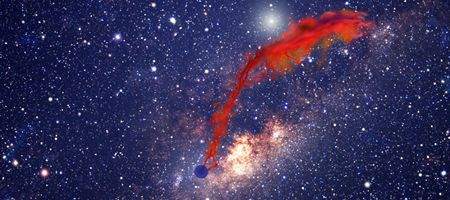The center of the galaxy is not only a crowded place, it’s blasted by shock waves, bathed in radiation and warped by owerful gravitational forces from the supermassive black hole at the region’s heart.

Nevertheless, new research by astronomers at the Harvard-Smithsonian Center for Astrophysics shows that planets can still form here. They’ve discovered a cloud of hydrogen and helium plunging toward the galactic center and representing, they say, the shredded remains of a planet-forming disk orbiting an unseen star.
“This unfortunate star got tossed toward the central black hole. Now it’s on the ride of its life, and while it will survive the encounter, its protoplanetary disk won’t be so lucky,” says lead author Ruth Murray-Clay.
The cloud was discovered last year by a team of astronomers using the Very Large Telescope in Chile, who suggest that it formed when gas streaming from two nearby stars collided.
But Murray-Clay and her colleague Avi Loeb have a different take on the discovery, pointing out that newborn stars retain a surrounding disk of gas and dust for millions of years. If one dived toward our galaxy’s central black hole, radiation and gravitational tides would rip apart its disk in a matter of years.
They also identify a possible source of the stray star – a ring of stars known to orbit the galactic center at a distance of about one-tenth of a light-year. Astronomers have detected dozens of young, bright O-type stars in this ring, suggesting that hundreds of fainter sun-like stars are also present. Interactions between the stars could fling one inward, along with its accompanying disk.
Although this protoplanetary disk is being destroyed, the stars that remain in the ring can hold onto their disks – meaning they could still form planets despite their hostile surroundings.
As the star continues its plunge over the next year, more and more of the disk’s outer material will be torn away, leaving only a dense core. The stripped gas will swirl down into the black hole, with friction heating it so much that it will glow in X-rays.
“It’s fascinating to think about planets forming so close to a black hole,” says Loeb. “If our civilization inhabited such a planet, we could have tested Einstein’s theory of gravity much better, and we could have harvested clean energy from throwing our waste into the black hole.”






